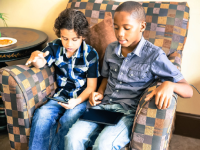Engaging Students with Social Game Mechanics
In-class games can build social-emotional, collaboration, and problem-solving skills when they bring students face-to-face for trading, arguing, judging, persuading, guessing, and bluffing.
Tabletop games are non-digital games played together socially. They can involve a board, dice, cards, pawns, and other physical elements, or just a group of people. Charades requires no pieces at all. Because tabletop games are played in a face-to-face setting, social mechanics are often part of the action. Social mechanics include:
- Trading
- Arguing
- Judging
- Persuading
- Guessing
- Bluffing
Players guess from drawn clues in Pictionary (PDF, 168KB) and negotiate and trade resources in The Settlers of Catan.
Scaling Games for the Classroom
Pandemic: The Board Game is a cooperative tabletop game that works well for teaching global interconnectedness. All players must work together to win. The board itself is a map of the world -- useful in teaching geography contextually. The goal is cooperating to stop global outbreaks and epidemics. The game teaches systems thinking and collaborative problem solving.
Playing board games with 25 students in a 40-minute bell schedule is logistically challenging. Many board games are limited to small numbers of players -- only three or four can play The Settlers of Catan at a time. What do the other 21 students do? Also, due to cost constraints, it's not feasible to have several sets of the same game. One solution is to take a project-based learning (PBL) approach and create centers or stations around the classroom, one of which involves a tabletop game. After all, the game should support curriculum, not be the focal point of instruction.
I used Pandemic as part of a PBL unit on the Columbian Exchange (the intentional and unintentional trade between Europe and the Americas in the 1600s). One group of students played the game, while the remaining classmates engaged in other simulation activities (often involving the mechanic of trading).
Another idea for adopting tabletop games in a classroom is to look for casual versions. Catan Dice Game and Pandemic: The Cure are dice games derived from their longer-form, board-based counterparts. Both versions teach the same skills, yet are faster to set up and easier to explain.
Tabletop games can also be used to model real-world events in relatable fashion. I use Monopoly when leading discussions on xenophobia. First, I ask who has played the classic board game (most students raise their hands). Next, I ask the difference between two-player and three-player Monopoly. The answer, of course, is that it's easier to win with just one opponent -- there is less competition for the same amount of resources. At this point, most students have that moment where they understand economic reasons (scarcity of resources) that lead people to fear immigration. Just as immigrants compete for people's jobs, the competitive system of the game changes by adding additional opponents.
Flipped Learning to Support Engaged Gaming
The flipped learning model works well to support classroom-based, tabletop gaming. Lower-order thinking tasks become homework, saving class time for student-centered, face-to-face engagement. Game rules can be flipped for home instruction, too, saving class time for the "fun" activity. It was much easier for me to post the rules for Pandemic (PDF, 30.3MB) as well as a YouTube video about setting up the board, before students entered the classroom. Catan Dice Game has a helpful set-up video, too.
BrainPOP offers a wide array of short-form, animated videos to teach content as homework. It's a subscription service, but there are free materials available on its educator community page. One benefit of a class subscription is that teachers can assign videos that relate to what is being taught in a game. For example, my students viewed the Columbian Exchange video at home prior to playing Pandemic in class. I assessed learning based on the online quizzes that accompanied the video.
Sometimes it is helpful to record short-form instructional lectures. The lessons can then be viewed as homework. A penalty for not participating would be not engaging in the class activity -- unless, of course, there are internet or digital divide issues. In those cases, my classroom is available before and after school hours.
Another option for flipped learning is Swivl, a tool for seamlessly recording a teacher's lectures. It's a robotic smartphone and tablet dock that tilts and rotates as it follows the teacher's movement around a classroom. Recorded lessons can be published on Swivl's cloud-based service, accessible by students from anywhere. One benefit of a device like Swivl is its plug-and-play ease of use. Simply dock your mobile device, grab the remote, and press record. Visit this page for more on Swivl as a tool to flip learning.
Students do not need to complete a board game to be assessed on in-game decisions and how skills relate to content. I use a simple exit slip to check for understanding. Students then reflect on the choices they made and the outcomes that resulted. The result is that tabletop games provide authentic, situated learning spaces in which students can engage socially in problem-solving and decision-making processes.
How have you used social game mechanics in your classroom?
